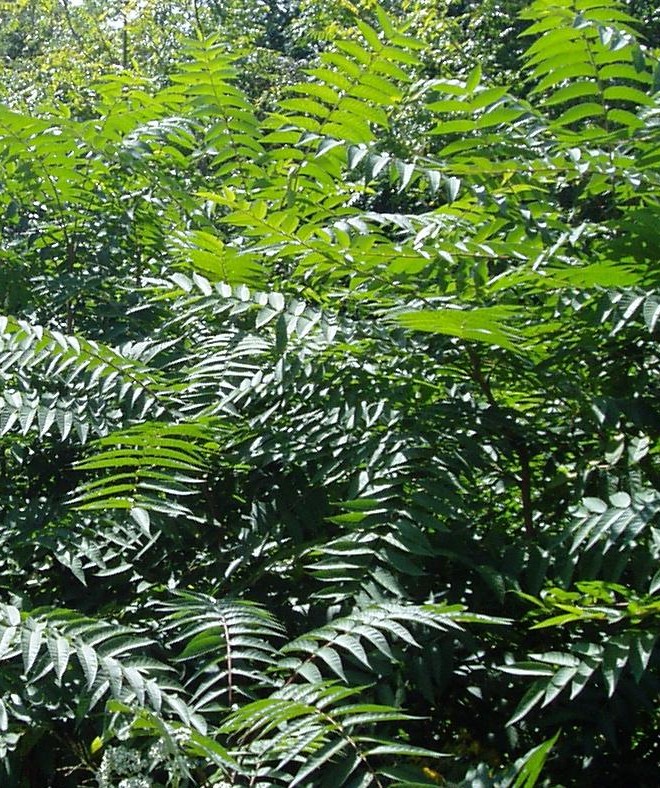 With a name like ‘tree of heaven’ you might think that it could be a desirable resident of your garden, but keep in mind that it is also called “ghetto palm” and “tree of Hell”. In China, where it is endogenous, it’s common name translates to “stink tree”. The tree is not without some positive attributes but it also has its share of serious faults. It is an open deciduous tree with a few coarse branches and pinnately compound leaves up to 24” long. In June, inconspicuous male and female flowers are produced on different trees and the male flowers are foul smelling. Tree of Heaven is very adaptable and tolerates salt, pollution, drought, and heat. It grows very quickly and can reach a height of 100 feet but is usually only 60’ with equal spread. Old established trees can be attractive but the life span is short, about 50 years. The greatest problem with Tree of Heaven is that it can become invasive; its seed production is prodigious, suckering is common, and it resprouts after cutting. Because of its toughness and adaptability to urban conditions it was widely planted in the 1800s as a street tree and is useful in areas where little else will grow like roadsides and seasides. Beware, plants that are for sale are usually not identified as to gender and you will get either a male with stinking flowers, or a female with an abundance of seeds that may produce new trees all over your garden.
With a name like ‘tree of heaven’ you might think that it could be a desirable resident of your garden, but keep in mind that it is also called “ghetto palm” and “tree of Hell”. In China, where it is endogenous, it’s common name translates to “stink tree”. The tree is not without some positive attributes but it also has its share of serious faults. It is an open deciduous tree with a few coarse branches and pinnately compound leaves up to 24” long. In June, inconspicuous male and female flowers are produced on different trees and the male flowers are foul smelling. Tree of Heaven is very adaptable and tolerates salt, pollution, drought, and heat. It grows very quickly and can reach a height of 100 feet but is usually only 60’ with equal spread. Old established trees can be attractive but the life span is short, about 50 years. The greatest problem with Tree of Heaven is that it can become invasive; its seed production is prodigious, suckering is common, and it resprouts after cutting. Because of its toughness and adaptability to urban conditions it was widely planted in the 1800s as a street tree and is useful in areas where little else will grow like roadsides and seasides. Beware, plants that are for sale are usually not identified as to gender and you will get either a male with stinking flowers, or a female with an abundance of seeds that may produce new trees all over your garden.
Type: Deciduous tree
Outstanding Features: Tolerance to harsh conditions
Form: Upright, open, with a few coarse brances
Growth Rate: Rapid
Bloom: Inconspicuous male and female flowers are different trees in spring; male flowers foul smelling; seed production abundant
Size: 40-60’ H w 40-60’ W
Light: Full sun
Soil: Tolerates infertile, dry soil
Hardiness: Zones 4-11
Care: Control spread
Pests and Diseases: Susceptible to verticillium wilt
Propagation: Seed
Outstanding Selection: None.
